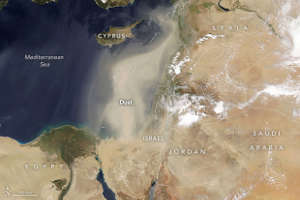Using AI to control energy for indoor agriculture
30 September 2024
Published online 23 September 2022
The air pollution most damaging to human health in the Middle East is almost all from industrial sources, not the desert.

NASA Earth Observatory image by Lauren Dauphin
Now, an international team of researchers, including from King Saud University and King Abdullah University of Science and Technology in Saudi Arabia, has analysed air quality all around the Arabian Peninsula, and revealed that most of that pollution comes from anthropogenic sources, such as marine traffic and the petrochemical industry. This is especially the case for the fine particulates in air pollution, which are those that pose the greatest threat to human health.
The team took air quality measurements aboard a ship that travelled around the Arabian Peninsula from late June to early September 2017; a period chosen to expose the instruments to a wide variety of pollution conditions. The instruments were able to pick up particulates ranging in size from the fine PM1 up to the coarse PM10.
The analysis found almost all the fine particulates detected were from anthropogenic sources, such as ammonia from industrial and agricultural activities, sulfur dioxide from the fossil fuel industry and shipping traffic, and black carbon from the incomplete burning of biomass and fossil fuels. In contrast, the coarse particulates mostly consisted of airborne dust.
The study is one of the first to measure fine particulate air pollution, says atmospheric chemist Charbel Afif, from Saint Joseph University in Lebanon.
“We know that we have a lot of problems with desert dust, but also a lot of problems from anthropogenic emissions,” says Afif. “However, all the assessments that were made till now targeted more the coarse part of the particles, so PM2.5 to PM10.”
Given the known health impacts of fine particulates, the authors modelled the excess mortality – the number of deaths above what would be expected based on historical trends – of annual exposure to these levels of pollutants. This analysis suggested that the air pollution due to PM2.5 measured would contribute to 5.9% of excess mortality for Cyprus, but as high as 15.9% of excess deaths in Kuwait. In contrast, PM2.5 pollution accounts for just 3% of excess deaths in the United States and 3.7% in Germany.
This level of excess mortality makes exposure to air pollution as much of a health risk in the region as tobacco use and high cholesterol.
doi:10.1038/nmiddleeast.2022.58
Osipov, S. et al. Severe atmospheric pollution in the Middle East is attributable to anthropogenic sources. Commun. Earth Environ. https://doi.org/10.1038/s43247-022-00514-6 (2022).
Stay connected: